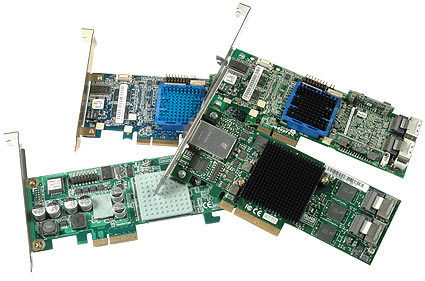Unified Serial RAID Controllers for PCIe
Conclusion
All four controllers are powerful and provide high storage performance as well as a plethora of features to provide both flexible, high-performance storage arrays for entry-level or for mid-range servers. All products support eight SAS ports, but can also be used to operate SATA drives, or a mixture of the two. Using SAS expanders, you can attach a multitude of drives; we consider the four candidates to be suitable for anything up to maybe 12 drives, since most of these cards were designed for internal drives. Have a look at models with external Mini-SAS ports if you need to hook up powerful storage appliances.
The ICP 5085BL is somewhat similar to Adaptec’s RAID 3805, but delivers better performance thanks to a faster XOR processor and double the cache memory. However, this comes at the expense of a slightly higher MSRP: $650 as opposed to $575. Both cards offer an impressive feature set and sophisticated management software, which has been fine-tuned over time, as Adaptec is one of the established players in the professional storage market. Atto requests a hefty $1,095, for which you get fewer RAID features (with the exception of RAID 4 support), and you will have to fine-tune the controller card to have it perform better. It doesn’t do badly, but the default settings don’t enable a feature that boosts read performance. It did well with a degraded RAID 5 array, as the write performance did not drop as with the other products Compare Prices on RAID Controllers.
Raidcore offers the most comprehensive software, which is a result of its architecture: the software is host-based, and thus depends on the performance of the host machine. Unfortunately, Raidcore does not yet support RAID 6 (nor does Atto), but you can span RAID arrays across multiple Raidcore controllers, and the performance level of the I/O benchmarks was excellent on our dual processor Xeon test system. Transfer rates are high, but the other controllers typically beat Raidcore in this benchmark.
If you don’t mind the storage controller taxing the host system with XOR calculation, and if you can live with limited operating system support, Ciprico/Raidcore will give you excellent bang for the buck. Adaptec will give you better overall performance in some areas, and at $575 it is very reasonably priced.
Join our discussion on this topic
Get Tom's Hardware's best news and in-depth reviews, straight to your inbox.
Current page: Conclusion
Prev Page RAID 6 Throughput With Degraded Array
Patrick Schmid was the editor-in-chief for Tom's Hardware from 2005 to 2006. He wrote numerous articles on a wide range of hardware topics, including storage, CPUs, and system builds.
-
Rik ...well,Reply
- Unless RaidCore is trying to peddle their VST Pro software,...aka as Fulcrum proprietary based ? which BTW you said no to, I don't see any advantages here.
Why?, ZFS is free !
And, where are the Drives for Solaris, or the xBSD's , or even MacOSX !!!?
-and still no, becuase their newer 54xx series doesn't support the other 'ix OS's.
Nope, unfortunately, not much to see here.
so, based on the above, Adaptec 5805,... or Areca,... blows this.
-Rikster
-
aapocketz ReplyFor SAS, the two connector segments were merged, which makes it possible to attach a SAS drive to a SATA controller using the continuous connector, but you cannot hook up a SAS hard drive to a SATA controller using the SATA connector (SFF 8482).
I think this paragraph has an error. I believe it should read
For SAS, the two connector segments were merged, which makes it possible to attach a SATA drive to a SAS controller using the continuous connector, but you cannot hook up a SAS hard drive to a SATA controller using the SATA connector (SFF 8482).
In fact I believe the statement should have less emphasis on the connector as its the actual controller that appears to limit the connectivity, the connector is just keyed to allow you to plug SATA drives into SAS but not the other way around.
from wikipedia: "SATA 3.0 Gbit/s drives may be connected to SAS backplanes, but SAS drives may not be connected to SATA backplanes."
I believe the fact that signaling voltages are nearly double on a SAS drive is significant to mention.
Let me know if I am wrong, I just started playing around with a bunch of SAS drives so I am figuring this out as I go.
-
Factors like spindle speed, density, latency etc. effects drive performance as much or more than bandwidth. A 300GB 2.5 15K SAS drive will smoke a 1TB 7200 SATA drive simply because it has about twice the IOPS. The bandwidth is meaningless if you can't get the data on and off the disk at the speed of the bus. Furthermore, except for the WD Velociraptor 10K+ spindle speed drives are non-existent in SATA but are prevalent in SAS. So from an interface standpoint they are very close but SAS drives are really intended for entirely different markets and applications and budgets I might add.Reply
-
Bicom Systems Great article - thanks for the comparison! We also did a piece on SAS and SATA, if you're interested : http://blog.bicomsystems.com/sas-vs-sataReply
